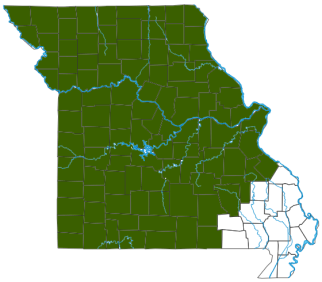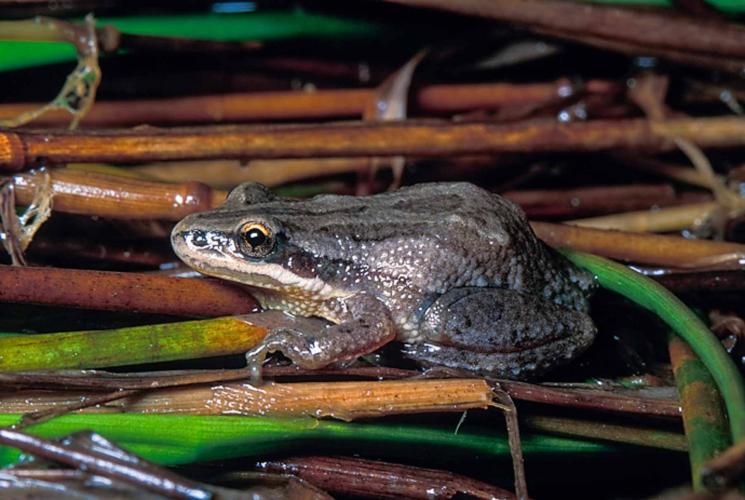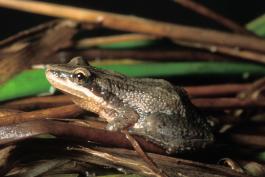
The boreal chorus frog, formerly called the western chorus frog in our state, is a small, gray or tan frog with dark stripes down the back. A broad stripe, which can be black, brown, or dark gray, extends from the snout through the eye and down each side to the groin. The head, body, and legs may be gray, tan, or brown. The three dark stripes on the back may be broad and continuous from the head to the back of the legs, or they may be broken into three rows of spots. There is usually a dark marking on the head between the eyes. Dark markings are gray or brown. The upper lip is white. The belly is white, and there may be a few gray spots on the throat and chest. During the breeding season the males have dark throats.
The call of the male boreal chorus frog is a vibrating or metallic clicking “crrreeeeek” that rises in pitch at the end; it lasts about a second. The sound is similar to running a fingernail over the small teeth of a pocket comb.
Similar species: In the hylid family, nine species, in three genera, are native to Missouri:
- Acris, the cricket frogs, one species: Blanchard’s cricket frog;
- Hyla, the treefrogs, three species: gray treefrog, Cope’s gray treefrog, and green treefrog; and
- Pseudacris, the chorus frogs, five species: spring peeper, upland chorus frog, Cajun chorus frog, Illinois chorus frog, and boreal chorus frog.
Due to variation of markings and similar calls, it is difficult to distinguish between the boreal, upland, and Cajun chorus frogs. But distribution can really help with identification: Of Missouri's five chorus frogs, only the boreal chorus frog and the spring peeper are not limited to southeastern Missouri, and the boreal chorus frog does not occur in southeastern Missouri.
Adult length (snout to vent): ¾ to 1½ inches. Females are larger than males.

Occurs nearly statewide, except in the southeastern quarter of Missouri, where it hybridizes with and also is replaced by the upland chorus frog and Cajun chorus frog.
Habitat and Conservation
This frog is most abundant in prairies but also occurs on agricultural lands, in large river floodplains, on the grassy edges of marshes, and in urban areas. After breeding season, they take shelter in animal burrows; under boards, logs, or rocks; in clumps of grass; or in loose soil. Breeding sites are usually in temporary bodies of water: flooded grain fields, ditches, woodland ponds, marshes, or river sloughs. They also will breed in fishless farm ponds that have aquatic vegetation.
Boreal chorus frogs do not burrow very deep and can tolerate freezing temperatures due to an increase in the level of glucose in their blood, which acts as an antifreeze.
In Missouri, the boreal chorus frog is often the first frog to be heard calling in late winter, but it is rarely seen because it remains hidden in vegetation.
Food
Boreal chorus frogs eat a variety of small invertebrates, especially beetles, flies, crickets, grasshoppers, ants, and spiders.
Status
The boreal chorus frog is a common species throughout most of the state, especially the prairie regions. It has been heard calling in scattered areas within the central Ozark Highlands but is yet to be documented by voucher specimens. Additional genetic studies are needed to better understand this species’ boundary in the southern and eastern part of its range in Missouri.
The boreal chorus frog in Missouri was long considered the “western chorus frog,” Pseudacris triseriata, but scientists now recognize them as two separate species. Our frogs haven’t changed — only their name and species designation. Western chorus frogs still exist as a species — but not in Missouri; they occur east of the Mississippi River. As ornithologists do with bird names, herpetologists assign official common names to reptile and amphibian species to correspond exactly with the scientific names.
Life Cycle
Breeding begins in late February or early March and peaks during April and into May. Calling may continue into July, especially in northern Missouri. Males chorus in temporary bodies of water and in fishless farm ponds. The male fertilizes the eggs as the female lays and attaches them to submerged grasses and twigs just below the surface, in clusters of 15–190. A total of 300–1,500 eggs may be produced per female. The eggs hatch within a few days or a week, depending on water temperature. Metamorphosis occurs in 6–8 weeks. Most individuals breed within a year. Lifespan is apparently no more than about 3 years.
Human Connections
These frogs help control populations of troublesome insects. Also, because they are sensitive to pollutants, they are an indicator species, whose presence and population numbers help us gauge the health of their ecosystem.
Ecosystem Connections
These small frogs prey on numerous insects and spiders, helping to control their populations, but they also fall prey to many larger predators at each stage of their life cycle. Adult boreal chorus frogs are eaten mainly by a variety of birds, small mammals, and snakes. Tadpoles are eaten by aquatic invertebrates and fish.
A study in northeastern Missouri showed that western mosquitofish (Gambusia affinis) are a primary predator of the boreal chorus frog. Although mosquitofish are only 1–2 inches long and have rather tiny mouths, the presence of these aggressive, pecking fish greatly increases tadpole tail injuries.
This is one of several frog species where, in addition to males that call, there are often noncalling "satellite" males. The satellite males position themselves nearby a calling male but remain quiet, still, and low to the ground. These noncalling males intercept and successfully mate with females that are attracted to the males that are calling. Apparently, the noncalling males, being less conspicuous, are less likely to be captured by predators. Also, they save energy by not calling. This is similar to the behavior of some male bluegills, called “sneakers” or “satellites,” which have the color pattern and behavior of females; they do not construct nests. They enter other males’ nest areas and fertilize eggs without alerting the territorial-nest-holding male.





































